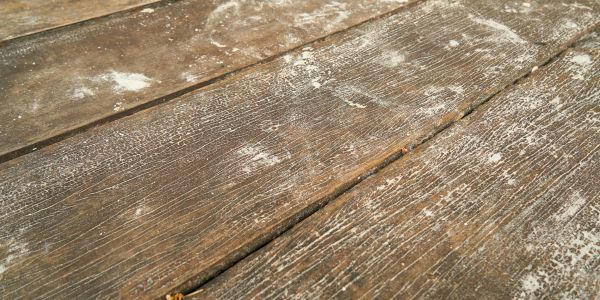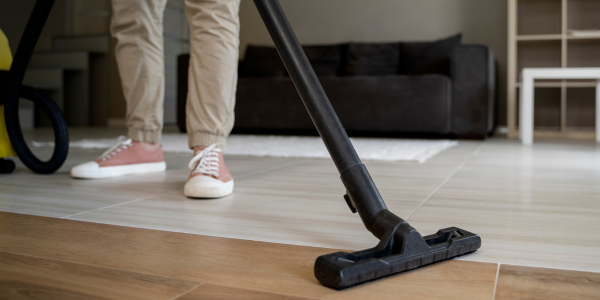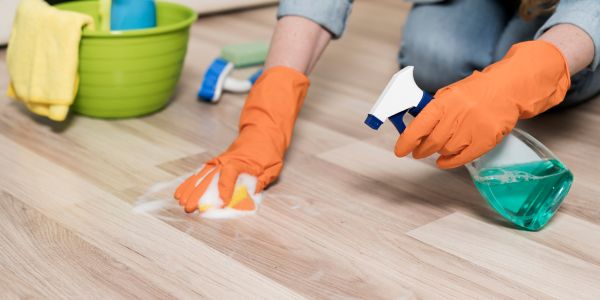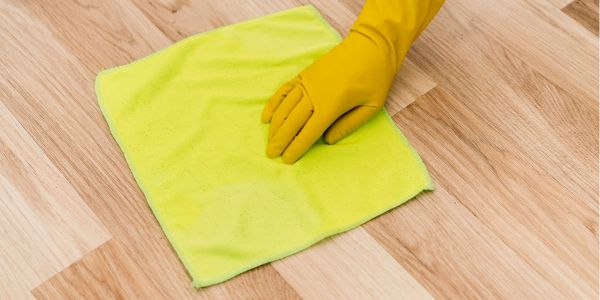WE'RE THE HARDWOOD EXPERTS. CALL US NOW: +1 878-217-6297
How To Remove Stains From Hardwood Floors: Your Complete Guide
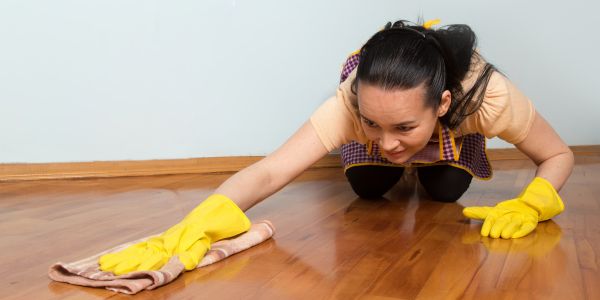
Stains on hardwood floors can significantly detract from the overall beauty and value of your home. However, they don’t have to be a permanent eyesore. Over my years of working with hardwood floors, I’ve seen everything from minor spills to major accidents, and I’ve learned that the key to successful stain removal lies in understanding the nature of the stain and handling it with the right techniques.
Whether it’s a splash of red wine during a lively dinner party or an oily mess from a kitchen mishap, each type of stain demands a tailored approach to ensure that you can remove it effectively without damaging the delicate wood beneath.
In this guide, I’ll share the insights and methods that have proven most effective in not only lifting various stains but also preserving the integrity and appearance of hardwood floors. From everyday household items to professional-grade products, you’ll learn how to address common and uncommon stains alike, ensuring your hardwood remains pristine and continues to enhance the warmth and elegance of your home.
Quick Action Is Key
An immediate response is crucial when dealing with stains on hardwood floors. The nature of hardwood means that liquids can quickly seep into the grain, causing stains that are not only unsightly but also difficult to remove once set. To prevent this, it’s essential to act swiftly.
As soon as a spill occurs, blot—don’t wipe—the affected area with a clean, absorbent cloth. Wiping can spread the liquid, increasing the affected area and pushing the spill deeper into the wood fibers. Instead, dab gently until the majority of the liquid is absorbed.
This prompt action helps minimize the depth and spread of the stain, significantly improving the likelihood of complete removal and maintaining the pristine condition of your hardwood flooring. By adopting this immediate blotting technique, you can keep many common household spills from becoming permanent fixtures on your beautiful floors.
Identify The Stain Type
Properly identifying the type of stain on your hardwood floors is crucial, as each type requires a specific treatment method. Here’s how you can tackle each major category of stains effectively:
1. Organic Stains (food, blood, wine)
Organic stains are those that come from natural substances and are typically easier to remove if treated promptly.
Steps to Remove Organic Stains:
Step 1: Blot the Stain – Immediately blot any excess liquid with a clean cloth. Avoid rubbing the stain as it can push it deeper into the wood.
Step 2: Mix a Cleaning Solution – Prepare a solution of one part hydrogen peroxide to two parts water. Hydrogen peroxide acts as a mild bleach, which can help lift the stain without damaging the wood finish.
Step 3: Apply the Solution – Soak a clean cloth in the solution and gently dab it on the stained area. Let it sit for a few minutes to allow the hydrogen peroxide to react with the stain.
Step 4: Wipe and Dry – After a few minutes, wipe the area with a damp cloth to remove any residue of the peroxide solution, then dry the area thoroughly with a clean, dry cloth.
2. Oil-Based Stains (grease, crayons, makeup)
Oil-based stains are trickier because they involve substances that can seep into the wood more deeply due to their greasy nature.
Steps to Remove Oil-Based Stains:
Step 1: Apply a Degreaser – Use a degreaser or isopropyl alcohol (rubbing alcohol) to break down the oils. Apply a small amount to a cloth and dab it onto the stain.
Step 2: Let it Sit – Allow the degreaser or alcohol to sit on the stain for several minutes to break down the grease.
Step 3: Blot Up the Oil – After allowing it to sit, blot up the degreaser or alcohol along with any loosened oil.
Step 4: Clean and Dry – Wipe the area with a damp cloth to remove any remaining degreaser and then dry it thoroughly with a clean towel.
3. Water Marks And Rings
Water marks and rings can vary in severity, but they generally affect the finish of the wood rather than the wood itself.
Steps to Remove Light Water Marks and Rings:
Step 1: Mix a Solution – Combine equal parts of vinegar and olive oil. This mixture helps both to break down the water mark and to condition the wood.
Step 2: Apply the Mixture – Apply the mixture to a soft cloth and gently rub it into the stain in the direction of the wood grain.
Step 3: Wipe and Polish – After treating the stain, wipe the area with a clean, dry cloth to remove any excess oil.
4- Dark And Stubborn Stains:
Dark and stubborn stains may require aggressive methods if gentler ones fail.
Baking Soda And Vinegar:
- Step 1: Create a paste using baking soda and vinegar.
- Step 2: Apply the paste to the stain and gently rub with a soft cloth, following the grain of the wood.
- Step 3: Allow the paste to sit for a few minutes to penetrate the stain.
- Step 4: Rinse the area with a damp cloth, then dry thoroughly.
Sand And Refinish:
- Step 1: If the stain persists, sanding may be necessary. Use fine-grit sandpaper and sand the area gently along the wood grain.
- Step 2: Once the stain is removed, clean the area to remove all dust.
- Step 3: Apply a matching wood finish to restore the area. Allow it to dry according to the manufacturer’s instructions.
By using these methods, you can address a wide range of stains effectively and maintain the aesthetic appeal and longevity of your hardwood floors.
Advanced Techniques
When conventional cleaning methods fall short, especially with set-in or particularly stubborn stains, advanced techniques such as using a Magic Eraser and floor buffing can be highly effective. These methods provide deeper cleaning without the harsh consequences of more abrasive approaches.
1- Use A Magic Eraser
The Magic Eraser is a versatile cleaning tool that works exceptionally well for lifting set-in stains from a variety of surfaces, including sealed hardwood floors. It functions through a micro-scrubbing action, which is gentle yet effective enough to tackle tough stains without the use of harsh chemicals. The eraser’s fine structure helps to break down and lift away the stain particles from the wood’s surface. It’s particularly useful for scuffs and smaller marks that don’t respond to usual cleaning agents. However, it’s important to use it with a gentle hand to avoid any potential dulling of the wood finish, especially on glossy or high-sheen floors.
2- Floor Buffing
For those who face persistent surface-level stains, floor buffing can be a lifesaver. Using a floor buffer equipped with a soft pad is an excellent way to rejuvenate your hardwood floor’s appearance. The buffer gently rotates over the stained area, polishing the surface and gradually removing the stain. This method is effective for large areas where hand scrubbing is impractical. It’s crucial to choose the right buffing pad—a too abrasive pad can damage the finish of the hardwood. Floor buffing not only helps in stain removal but also in restoring the natural shine and protective coating of the floor, making it look newly refinished. This technique is best used for lighter stains that haven’t penetrated deep into the wood’s surface.
These advanced techniques offer more powerful solutions to challenging stains and can help maintain the pristine condition of hardwood floors without resorting to drastic measures like sanding or refinishing. They serve as valuable tools in preserving the longevity and aesthetic of your flooring.
Preventing Future Stains
Maintaining the beauty and longevity of your hardwood floors is not just about addressing stains after they occur, but also about preventing them in the first place. Effective prevention strategies can significantly reduce the risk of stains and extend the life of your flooring. Here are some essential practices to keep your hardwood floors pristine:
- Routine Cleaning: Consistent cleaning is vital in preventing dirt and spills from settling into the wood and becoming permanent. Use a microfiber mop or cloth for daily cleaning, as it effectively traps dust and debris without scratching the floor surface. It’s important to select the right cleaning products specifically designed for hardwood floors. These products clean effectively without damaging the wood or leaving harmful residues. Regular cleaning not only maintains the appearance of your floors but also enhances their durability by removing abrasive particles that can wear down the finish over time.
- Protective Coatings: Applying a high-quality sealant or wax to your hardwood floors can create a barrier against stains and spills. These protective coatings seal the pores of the wood, making it more difficult for liquids and oils to penetrate. Periodic application of these products, typically once a year or every other year depending on foot traffic, can significantly enhance your floor’s resistance to stains and damage. This step is particularly crucial in areas with high humidity or exposure to water, as it prevents moisture from seeping into the wood and causing warping or staining.
- Rugs and Mats: Strategic placement of rugs and mats can dramatically reduce the likelihood of stains. Place these in high-traffic areas such as hallways, near entryways, and under dining tables, where spills and wear are most common. Rugs not only catch spills before they can reach the floor but also reduce the amount of dirt tracked across the wood. Choose rugs with a natural backing material, such as cotton or felt, to avoid any potential discoloration of the wood from synthetic rubbers or plastics.
When To Call A Professional
Dealing with deep, pervasive stains on your hardwood floors can be daunting. When stains penetrate deep into the wood or cover a significant area, the expertise of a professional is invaluable. At Hardwood Flooring Los Angeles, we specialize in addressing complex flooring challenges, ensuring your hardwood retains its beauty and value. Our team of experts is equipped to assess the extent of the damage and determine the most effective course of action, whether it involves precise sanding and refinishing or the replacement of selective planks.
Why Choose Hardwood Flooring Los Angeles?
- Expertise: With years of experience, we have honed our skills in all aspects of hardwood floor restoration, ensuring we can tackle any challenge efficiently.
- Tailored Solutions: We understand that each floor and stain is unique. Our approach is customized to meet the specific needs of your hardwood floors, guaranteeing optimal results.
- Advanced Techniques: Utilizing the latest tools and techniques, we restore your floors with minimal disruption and maximal effectiveness.
- Customer Satisfaction: Your satisfaction is our priority. We are committed to transparency and open communication throughout the restoration process to ensure your expectations are met and exceeded.
If your DIY stain removal efforts have been unsuccessful or if the scope of damage is beyond what typical home remedies can address, it’s time to call in the experts from Hardwood Flooring Los Angeles. Don’t let stains diminish the elegance of your hardwood floors.
Contact us today to schedule a consultation, and let us help you restore your floors to their original splendor. Visit us at Hardwood Flooring Los Angeles or call us to discuss how we can assist in rejuvenating your valuable flooring.
